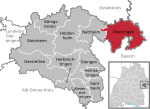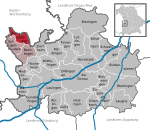Neresheim Abbey
1095 establishments in Europe1764 establishments in the Holy Roman EmpireAugustinian monasteries in GermanyBenedictine monasteries in GermanyChristian monasteries established in the 1090s ... and 4 more
Imperial abbeysImperial abbeys disestablished in 1802–03Monasteries in Baden-WürttembergOstalbkreis

Neresheim Abbey or the Abbey of Saints Ulrich and Afra, Neresheim (German: Abtei Neresheim or Abtei der heiligen Ulrich und Afra) is located above the town of Neresheim in Baden-Württemberg, southern Germany. It is now a Benedictine monastery and is part of the Beuronese Congregation.
Excerpt from the Wikipedia article Neresheim Abbey (License: CC BY-SA 3.0, Authors, Images).Neresheim Abbey
Alte Kösinger Straße,
Geographical coordinates (GPS) Address Website Nearby Places Show on map
Geographical coordinates (GPS)
| Latitude | Longitude |
|---|---|
| N 48.75587 ° | E 10.34366 ° |
Address
Abteikirche Neresheim
Alte Kösinger Straße
73450
Baden-Württemberg, Germany
Open on Google Maps











